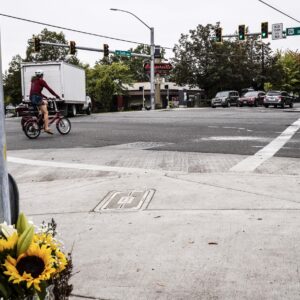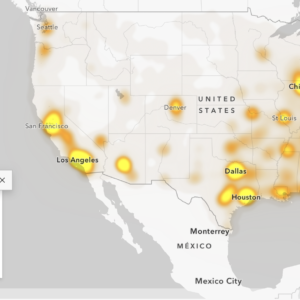“The design of the facility is so focused on traffic movement that more changes are needed. If changes result in slowing traffic down, I believe that is an acceptable tradeoff.”
– Kris Strickler
ODOT has just released a statement from Director Kris Strickler following last week’s death of Sarah Pliner at on SE Powell Blvd (State Highway 26).
Here’s the full statement:
“Powell Boulevard (U.S. 26) was originally established and designed as a highway to move freight and people through Portland quickly and efficiently. Recent incidents on Powell, including a tragic death on Oct. 4, are evidence that this road cannot, and should not, function as a traditional highway anymore. It’s time to make changes to ensure the safety of all users.
I have directed our team to evaluate possible options to quickly transform Powell into a safer roadway.
Recognizing that travel speeds dramatically affect the likelihood and severity of crashes, last year we reduced the speed limit on Inner Powell to 30. We also built pedestrian islands and signalized crosswalks that help make the currently-designed road function more safely by making bicyclists and pedestrians more visible. But the truth is that the design of the facility is so focused on traffic movement that more changes are needed.
In recent years, we’ve slowed traffic speeds, added protected crosswalks, installed wider bike lanes, and reduced travel lanes on our urban highways in Portland. We’ve even transferred ownership of an ODOT road to local control. To keep our community safe, no change is off the table.
To connect Oregon communities and connect Oregon to the rest of the region and the world, ODOT spent the last century building highways. These highways are and will remain essential as they continue to carry millions of Oregonians and billions of dollars of commerce every day. Our communities, businesses, and state need freight access in order to continue to thrive, but we know that we can increase safety for all users and still serve the needs of our communities and our state.
If changes result in slowing traffic down, I believe that is an acceptable tradeoff. My hope is that most people would make the same choice.
There will be a community forum on Oct. 20 at 6 p.m. at Cleveland High School. Representatives from the Portland Bureau of Transportation, ODOT, Portland Public Schools and TriMet will be there. I will be there as well. ODOT will be prepared to discuss ways we can make swift and meaningful changes to Powell Boulevard at this event. I encourage you to attend and bring your suggestions.”
Kris Strickler,
Director of the Oregon Department of Transportation
This is an amazing statement for an ODOT director to make so soon after a collision like this. Especially since his own agency spokesperson said just last week that it was “premature” to blame ODOT for what happened. It makes me think ODOT is feeling very exposed in terms of their responsibility for what happened. After all, in 2018 the agency made an intentional choice to remove bicycle infrastructure from the exact corner where Sarah Pliner was hit and killed just a few days ago. Those changes made the intersection less safe for bicycle riders, while doing nothing to prevent bicycle riders from using the intersection.
This could be a golden opportunity to make substantive change on Powell Blvd. Or it could be a savvy PR move from ODOT to try and cover up a bad news cycle. Time will tell. Stay tuned for more coverage.







Thanks for reading.
BikePortland has served this community with independent community journalism since 2005. We rely on subscriptions from readers like you to survive. Your financial support is vital in keeping this valuable resource alive and well.
Please subscribe today to strengthen and expand our work.
Good news. It’s frustrating it takes a tragedy to get ODOT’s attention.
I realize it’s unlikely, but I hope the agencies involved give serious consideration to a MAX extension when rebuilding the road. It’s only four miles between SE 17th and I-205. It’s far and away the most promising corridor in the city for light rail, both in terms of potential ridership and corridor width. Between Foster and 82nd, half the ROW already exists in the form of frontage road parking. Elsewhere the road is mostly flanked by parking lots and strip malls. The line could be built for a quarter of the cost of the SW corridor, and would probably see higher ridership.
I know rail is technically better than buses but a new MAX line would be expensive and a huge political lift.
A BRT on it’s own lane/”track” could be built and operated for a fraction of the cost as a MAX line, and run every 5-10 minutes all the way to Gresham.
If built like the viaduct from SW Lincoln to the tillikum bridge, buses and MAX could share a track, and buses could continue on from wherever a MAX line ends.
(This would avoid the problem with the Orange line on McLaughlin: “why does it just end here instead of continuing on to ________?”)
Generally you can build BRT for less but operating it costs more than a train. BRT has even begun to be replaced in the South American countries that implemented it in favor of rail.
Yes, but do you trust Trimet to get BRT right?
ODOT is never going to let them take 50% of the capacity on Powell away for bus lanes. If you are building a fully-elevated transit ROW over Powell, the BRT will cost nearly as much as LRT.
Dedicated bus/bike lanes would be a lot more efficient and flexible than the overpriced trains.
How are diesel busses stuck in traffic on Powell more efficient than a fully-electric light rail train with its own ROW?
I think the idea is that dedicated lanes would allow the diesel buses not to be stuck in traffic, assuming they’re built along the entire line.
Trolley buses and BEVs don’t burn diesel.
Trains have higher capital costs but are cheaper to maintain and operate. For high-volume transit they’re far superior to buses.
Sure, they reduced the speed limit, but does anybody actually abide by it? Is it ever enforced?
I cross SE Powell a few times a day. Motor vehicles are constantly going faster than 30 mph.
Powell Blvd is one place where there must be speed trap cameras.
Maybe even put some planter / flower boxes in the median or on the x-walk islands, dedicated bus lanes, etc. If you make it look less like a 4 lane “urban highway” people won’t drive on it like it’s a highway.
Of course this is good news. And yet…
Nothing has changed except Sarah’s unnecessary death. The data was clear: ODOT knew it was dangerous in that location. Their data said so. Advocates said so. Common sense said so. That it takes yet another person dying to make policy change just demonstrates a massive lack of leadership and thoughtful planning and smacks of reactionary policy.
Unless this results in an ODOT statewide policy change–specifically: sacrificing throughput for pedestrian/cyclist/transit safety–then this is more a political and public relations stunt than anything else.
It doesn’t even require sacrificing throughput, just speed of throughput.
This is great for ODOT finally realizing this ugly stroad is dangerous and express how they want to change that. However, it’s one of those situations where for now it is just talking the talk and not walking the walk just yet. I will believe it when I see it. I don’t trust ODOT to keep their word.
Here is some history for those of us that are new to this topic…
City gives in to state demand to remove bike lanes from SE 26th Avenue
This is a wild idea but maybe just make the roads safe before someone dies.
Alternately, there are at least two other people who have been killed by cars on Powell within a few blocks of that intersection, so perhaps the right time to have seriously invested in safety improvements was after those deaths?
Well this is good news.
While it is good news, everything Strickler said about the street needing to change, etc. has been true for DECADES. Only the date of the latest victim’s death is new. ODOT could have its pick of deaths to mention going way back.
I was involved in a 1990s project to make changes to ODOT’s MLK Blvd. to improve its function as a main street instead of a pure highway. That project was decades overdue even back then. Powell in the 90s was no better than MLK was, yet ODOT not only didn’t tackle Powell back then, it was doing things to make it WORSE only a couple years ago.
Here’s a photo of mothers creating a human chain to protect their children crossing Powell–from the 1950s!:

(from https://vintageportland.wordpress.com/?s=powell+blvd&submit=Search )
70 years after that photo, ODOT still hasn’t bothered to put school zone or school crossing signs in front of the school where last week’s death occurred.
“ODOT Director wants to be reactive and not proactive”
I appreciate his belated change of priorities, but I find his smiling face jarring. I’d rather see him mourning at the site of her terrible death or consoling the victim’s loved ones for a tragedy for which his agency shares blame.